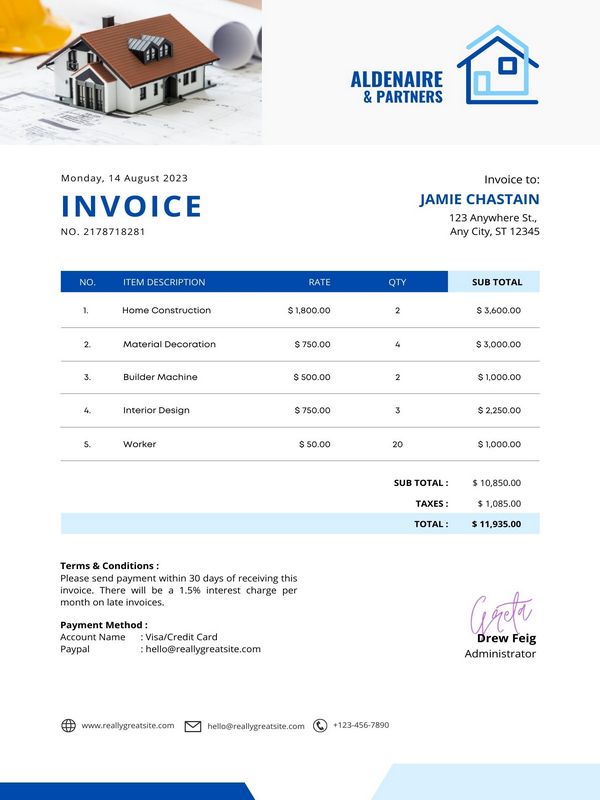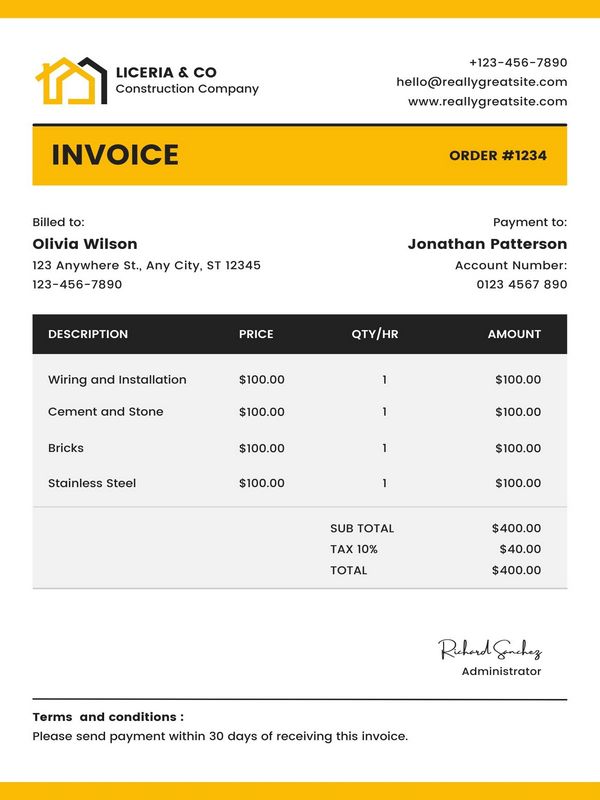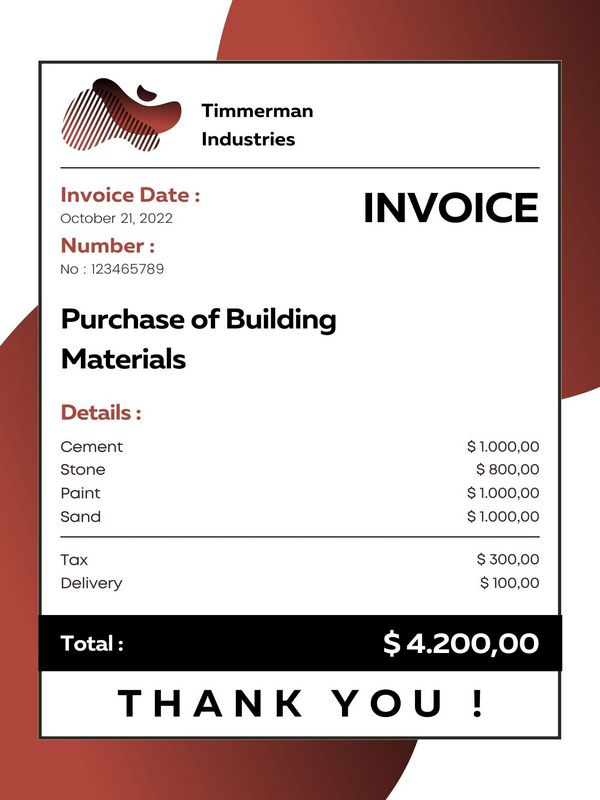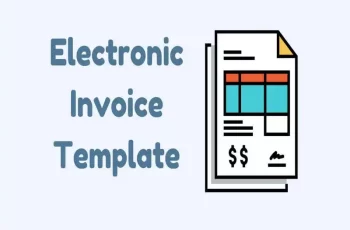Are you tired of struggling to pay your contractor promptly? Do you want to know how to create a construction invoice template that will save you time and money? This blog is for you! In this article, we will teach you tips on creating a construction invoice that accurately reflects the work performed and ensuring payment is received promptly.
Additionally, we will discuss what information should be included in this document and offer advice on avoiding common invoicing mistakes.
Lastly, we’ll outline the steps involved in disputed invoicing and provide helpful tips. Ready to begin saving time and money on your next construction project? Let us help!
Table of Contents
How to create a construction invoice

Construction Invoice Template
A well-designed construction invoice will save you time and money. Here are the tips that will help you create an invoice that is effective and efficient:
- Include all the required information on your construction invoice, including hours worked, materials used, labor rates, and other pertinent details. This will help ensure accurate billing and avoid penalties or delays.
- Be realistic in preparing your construction invoice. Avoid quoting overly high labor rates or using excessive amounts of expensive supplies; these factors can lead to inaccurate billing and added costs.
- Ensure you are following all the necessary regulations related to building projects; failure to comply can result in hefty fines or even imprisonment.
How to pay your contractor promptly?

Construction Invoice Template Excel
When paying your contractor, the sooner you pay them, the sooner they can start working on your project and the less money you will spend. Here are a few tips to help make sure that happens:
- Make sure you are properly tracking invoices. Use invoice management software or a good old-fashioned spreadsheet to track when materials were ordered, when work was done, how much was paid for each job category, and what is still owed. This way, you know exactly where you stand financially with your contractor and can avoid any potential misunderstandings or disputes down the road.
- Send payment reminders to your contractor. Payment processing fees can add up quickly, so be aware of them. By sending regular reminder emails and notifications about bank account changes or new payments due from other customers, you’ll prevent any surprises during tax season (which almost always falls in late April) or at other delicate moments in contract negotiations.
- Payment processing fees can add up quickly, so be aware of them. By using online calculators like this one, which consider various factors like geography and load frequencies, contractors should know how much money they’re likely to save by choosing a particular payment gateway.
- Ensure that the terms of your contract are followed. Make sure all deadlines listed in your agreement are met and provisions for change orders If there is anything amiss with the project after it starts — even if something minor like landscape dimensions.
Tips for avoiding common construction invoicing mistakes
To save time and money on your construction project, make sure you follow these tips:
- Always include a description of the work performed in your invoice. This will help ensure that the bill is accurate and complete.
- Include photos if possible—this will help illustrate what was done and help reduce disputes down the road.
- Itemize all costs- this will make it easier for contractors to understand exactly how much they are owed and prevent any misunderstandings or discrepancies later.
- Make sure to attach the required documentation- including licenses, permits, blueprints, etc.- to your invoice as proof of completion so there are no surprises when payments are made.
What information should be included on a construction invoice?

Construction Invoice Template PDF
A construction invoice should include the contact information for the contractor, a list of materials and supplies used, a list of hours worked, and a list of costs incurred. Beyond that, it can vary depending on your specific project.
For example, if you’re constructing an outdoor patio or deck using wood products like boards or lumber, you might include specifications such as the width and length of each board or how many feet in height each piece of lumber should be.
If you’re installing drywall, specific details, including wall type (single-ply versus double-glazed), layout (cabinet style vs. open layout), number of studs per foot, and tape measure Specifications, would also be beneficial to have on your construction invoice.
While including these types of detail may seem excessive at first glance, they will ultimately save time by ensuring accuracy in measurements and help prevent any misunderstandings during installation that could lead to additional costs down the road.
Construction invoices are important documents that track financial and physical progress throughout a project – making them indispensable for successful home renovation projects and commercial ventures involving new building construction or repairs.
Following simple guidelines when preparing your construction invoice will minimize expenses and increase transparency between all involved parties, which is always beneficial to business success. Read Also: How to Easily Create and Print Electronic Invoice Template With 5+ Free Sample
What are the benefits of using a construction invoice?

Construction Invoice Template Word
Here are three benefits of using a construction invoice:
- A construction invoice can help to save time and money.
- A construction invoice helps to avoid misunderstandings between contractors and clients.
- Construction invoices can help the contractor keep track of the project’s progress. This document will list all expenses incurred during the work, including materials, labor, subcontractors, etc., and a corresponding payment for each expense.
- Law often requires a construction invoice to enforce payments from contractors or clients who still need to complete their part of the job according to contract specifications or contractual obligations. By establishing clear milestones and documenting everything done up until this point, you will be able to enforce your rights without resorting to too much violence on either party’s part.
- Establishing deadlines for when specific tasks should be completed allows both parties more clarity about what needs to happen next for completion date predictions to come true. When there is more transparency around timelines, it becomes easier for everyone involved – contractor included –to stay organized and make informed decisions while working on a project.
What are the drawbacks of using a construction invoice?
A construction invoice is a document that summarizes the cost and time frame of a construction project. It can be very time consuming to create, especially if you’re working with multiple contractors.
A construction invoice can also be inaccurate, as it may reflect only some costs incurred during the project. This inaccuracy could lead to disputes between contractor and customer.
An accurate and thorough construction invoice is essential for maintaining good relations with your contractor(s). That way, both parties know exactly how much money they are owed and when payment should be made. Also, keeping track of expenses throughout the project will help prevent any financial surprises down the road.
How to dispute a construction invoice?
Here are ways of dispute:
- Dispute a construction invoice by contacting the contractor directly. Construction invoices are usually very detailed and can be quite confusing. That’s why it is important to contact the contractor directly if you have any questions about the bill or dispute its accuracy.
- Doing this will give you an accurate picture of what exactly happened during your project and avoid any potential misunderstandings or disputes with the bill issuer.
- You may also want to contact your bank or financial institution if you have any questions about how much money you owe since they can help resolve any discrepancies quickly and efficiently.
- Finally, it is always advisable to consult with a lawyer if there are specific legal issues that need to be addressed when disputing an invoice, such as contract interpretation or fraudulence on behalf of the contractor.
Conclusion
This blog post discussed tips on creating a construction invoice template that will save you time and money. We also discussed the various ways you can pay your contractor and some common mistakes that contractors make when invoicing customers. Finally, we covered four situations where you might need to dispute an invoice, so read through the tips before deciding what to do.

